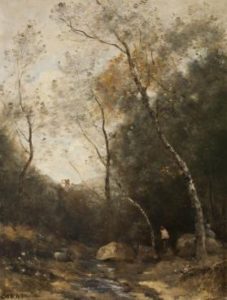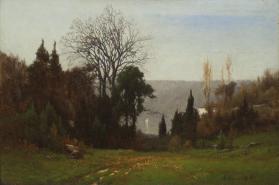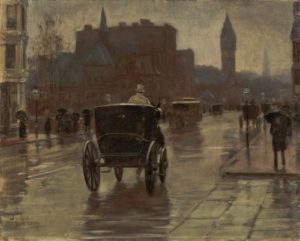
Camille Corot
If you love landscape painting and are curious about connections between the American and French traditions, then you will be rewarded by the “Paths to Impressionism” exhibit at the Newark Museum.
Pairing the two cultures is bound to be fruitful. After all, French and American artists in the 19th century simultaneously took landscape painting to heights of expression and innovation unmatched in art history. The Americans, fired up with religion, transcendentalism, and the natural wonders of the continent launched the Hudson River School. The French artists, worried about urban alienation, sought a reconnection with nature by trooping out to the countryside and painting the scenery right on the spot, en plein-air.
One thing led to another. There were schools within schools, breakthroughs and reconsiderations, and cross-fertilization between the two cultures. The Newark Museum exhibit uses 42 paintings from the Worcester Art Museum to show how some of these threads spun out and entwined.
My only misgiving is with the title of the show, which leads you to expect an exhibit about the development and triumph of impressionism, which it isn’t. Yet that turns out to be a good thing, because that story has been told many times and this is a different one.
This exhibit, being small and covering a lot of ground, is more anecdotal than comprehensive, and yet its story is subtle and ambiguous, which is more like reality than the simplifications histories tend to become.
It begins with a snapshot of the Barbizon School, the French movement that sought to convey the spiritual fullness of life on the land. The artist you need to look at here is Jean-Baptiste-Camille Corot. Instead of hitting you over the head with scenes of noble peasant simplicity, Corot drops you by a riverbank. There, he shows you how all the elements blend — the air blurry from the river, the river reflecting the sky, the tree going up like smoke, the tall grass swallowing the legs of a fisherman.

George Inness
No American artist learned more from Corot than George Inness, the other giant in this exhibit. Inness brought intimacy to the sometimes bombastic Hudson River tradition. His paintings are atmospheric gems that also manage to be true to place, as in his twilight scene, “Opposite the Palisades.” The mood, or moodiness, that he tapped into, that sense of quiet and dimming light and etherealness – seen in schools like tonalism and luminism — became a hallmark of American landscape.
In contrast to this spiritual approach, the French were delighting in the surface of things. All this outdoor painting among the peasant folk gave them other ideas, having to do with immediacy, color and sparkle. A few examples, like Alfred Sisley’s happy hillside panorama, “The Washhouse,” are enough to convey the charm and sheer exuberance of early impressionism.
Something had to give. The transcendental American artists were off pushing further and further into darkness, which, in artists like Alexander Wyant, was starting to look pretty bleak and desolate.

Childe Hassam
But Americans still went to Paris to learn, and one result was an odd amalgam – a dark and moody impressionism. Artists like Willard LeRoy Metcalf adopted the tiny brushstrokes of the French, but did it without breaking up the color, so instead of flicker, the paintings look furry.
The plain truth is that Americans never really got the hang of impressionism. Oh, some of them could do it, but it always looked derivative. Artists like Childe Hassam, who dominates the last gallery, never understood the all-overness of the impressionist surface, never jumped in with both feet, and thought it was OK to dab like Pissarro in one passage and do little wet-on-wet, like John Singer Sargent, in another.
And that’s where things draw to a close, here. The “Path to Impressionism,” which sounds like a glorious trip – and it was for the French – looks more like a capitulation for the Americans. We know that artists like Albert Pinkham Ryder and Ralph Blakelock continued fearlessly into darkness and insubstantiality and found their own lonely greatness. But impressionism was the big bus. The Americans who first climbed aboard didn’t seem to know where they were going, but as subsequent generations caught transfers into movements like abstraction and cubist-inspired precisionism, they got their bearings, and made big contributions.
But that’s another story.

